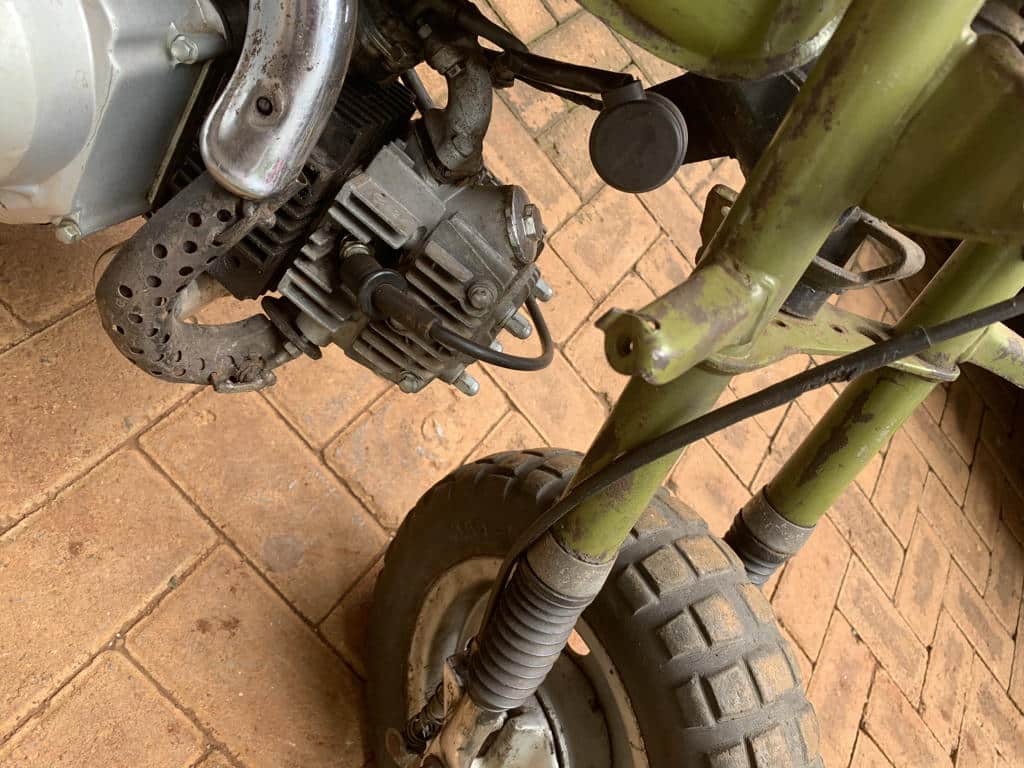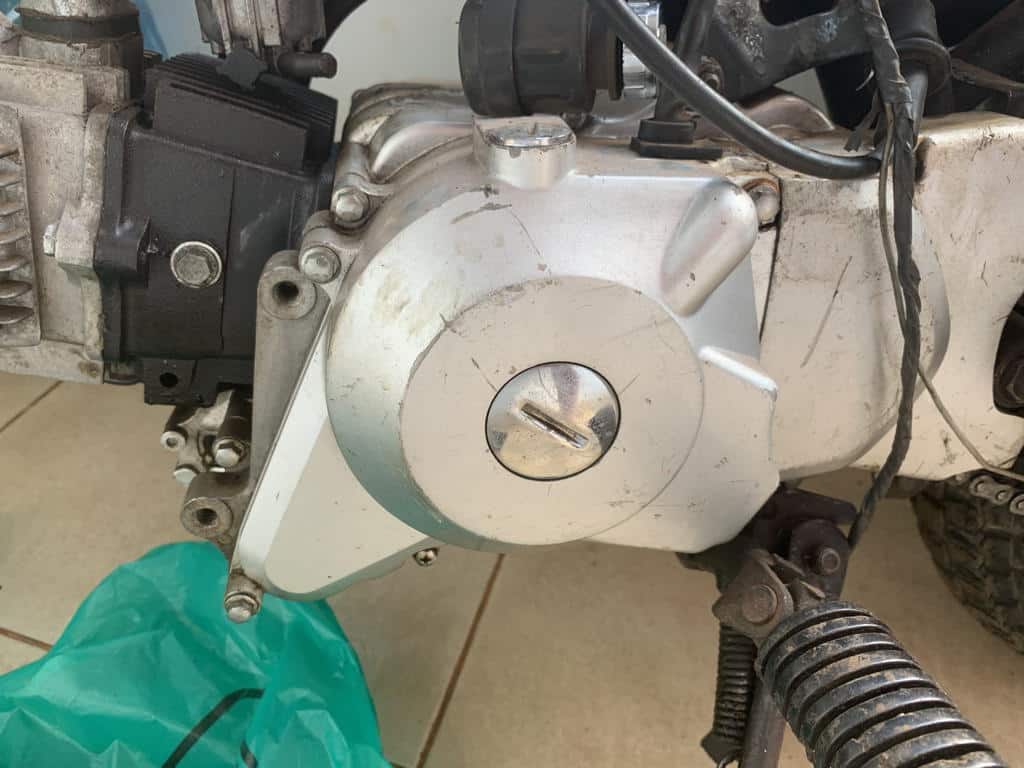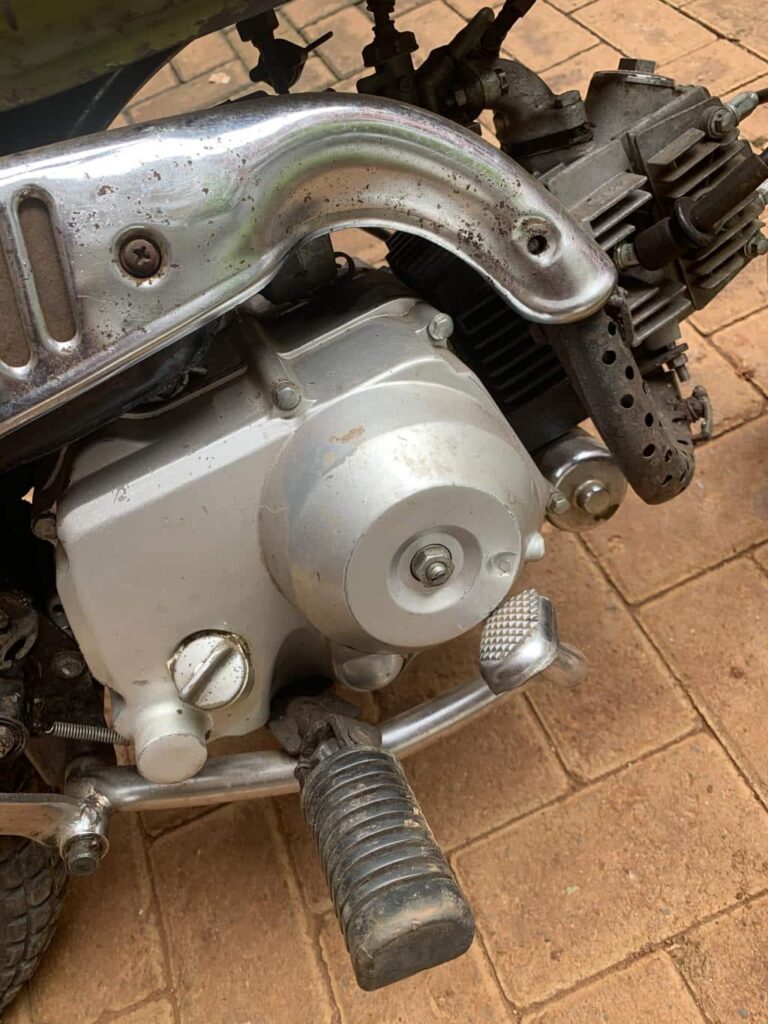This step of having a first assessment should normally be taken before buying a car or a motorbike. But we’re talking of monkey business, right? So: as I wasn’t even in Nairobi when my girlfriend bought the bike on my behalf, it has to happen now. After some general history about the Monkey and me, this time we’ll have a first assessment of our new aquisition.
Vehicle Identification
Normally you should find various stickers ans bagdes on the frame of a bike or in the enginebay of a car with a VIN. A vehicle identification number. This Honda Monkey didn’t have any, but just a stamped in number in the frame.

Given the fact that it has a rear suspension we can conclude that it is a model after 1974. Any model before 1974 are the hardtails. By the decals on the tank one can conclude it’s a 1976 model. Here’s an overview of all models. But any literature I could access speaks of yellow as the one and only color of 1976. Which turned out is true for US. On the European and Japanese market two other colors where sold. White and – the one we have – G20 papaw green. Which also seems to be quite rare. Did we find a true gem?
First assessment of the engine
Now for the first time it get’s really tricky on this bike:
engine left side engine right side
If you take a closer look there a two important parts missing: the gear lever on the left and the kickstarter on the right. Clearly this is not the original engine. Anyway – whoever did the swap did a fairly good job. killswitch and start button work, a complete wiring harness for this engine was installed and even a bigger battery.
As much as it works it doesn’t look good and it’s far from original. Worst to see at the side cover which might not be even from a motorbike. It also might explain, why the brake pedal gets in touch with the engine cover

First assessment of the paper work
This was fast and easy: there isn’t just any. Normally you would check the logbook or any comparable documents like a CoC for newly imported vehicles if you get what you’re promised. This bike doesn’t have a registration which already brings me to my first question. Does it need to have one? The seller claimed it doesn’t … but hey, it’s the one who will care the least once sold. Which regulations from NTSA apply? And if it needs a registration how to get one for an almost 50 year old bike? Maybe someone can shed some light on those legal issues in the comments below.
First assessment of the condition
To be honest: though it runs I would rate it “poor, but not hopeless”. Lot’s of parts like the fenders, the headlamp and indicators are missing. Quite unusual BTW the indicators. The front fork has the mountpoints though indicators were uncommon on this model.

Other parts are poor like the exhaust or the badly repaired seat. Brakes, chain and tires need to be serviced and most certainly replaced. If it is a gem, it’s at least a very unpolished one.
And the polishing that has to be done raises a very cruial question:
Which type of restauration to choose?
- The sheer minimum would be to service the bike, replace missing parts and keep all the patina it acquired over the last decades. Keeping it in an “as-is” condition, just with proper maintenance is one of the latest trends when it comes to car and bike restorations. It had a life, it was used, it shall look used. As much as it would save money my feeling is that it deserves more. Maybe any vehicle deserves more than this.
- The next level would be to come to an “as new” condition. Let it look like a shiny new bike, right out of the 1976 show room. Everything that is faulty or broken has to be refurbished or replaced with original new parts to get it back to it’s old glory.
- A “better as new” condition. Basically the same as variation before but with some enhancements, esp. when it comes to new manufacturing techniques or materials. E.g. replacing some heavy weight cast iron parts with lighter aluminium. But overall it will be the same bike at the end.
- Even one step further would be a “contemporary rebuild”. Let’s say: drum brakes will be replaced by disc braces. Or old light bulbs will be substituted by LED lights. This would be the bike Honda would build today using the same basis. Borders are quite blured between 3) and 4) and sometimes even with the next level. Which would be
- A “custom restauration”. Just take the bike as a basis to create something completely new. I’ve seen Superbike handlebars on Honda Monkeys with some addtional motor tuning all the way from big bore kits up to 200 cc to even superchargers. Or some relaxed Bobber? You’ll find so many inspiration on the internet and YouTube especially.
Any recommendations?
So guys, what are your ideas when it comes to rebuild this bike? Preserving, restoring, enhancing, tuning? What would you do having this mini trail in your garage? Give me some comments below. And again: if anyone has some information how to get this 1976 Honda Monkey fully legal onto kenyan roads I’ld be more than happy to hear about this.

